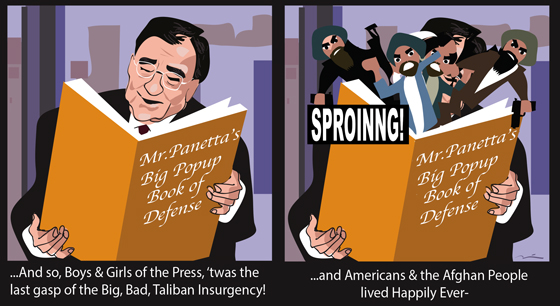The Taliban claimed credit for today’s suicide attack in the Zhari district of Kandahar that killed four US soldiers during a “partnered” military operation. The district of Zhari, along with Panjwai, is considered to be the cradle of the Taliban movement in Afghanistan.
The International Security Assistance Force announced the deaths of four soldiers early this morning in a press release that had few details:
Four International Security Assistance Force service members were killed by enemy forces during a partnered operation in southern Afghanistan Oct. 5.
It is ISAF policy to defer casualty identification procedures to the relevant national authorities.
Afghan officials told Pajhwok Afghan News that the four soldiers who were killed were Americans, and they were killed by a suicide bomber:
But the Kandahar governor’s spokesman, Javed Faisal, told Pajhwok Afghan News the Americans were killed in a suicide bombing in the Sinzari area of Zhari district. Also, four militants were eliminated as a result of the offensive.
The Taliban claimed credit for the attack in a statement released on their website, Voice of Jihad. In the statement, the Taliban said the attack included 10 IEDs and two suicide bombers, who were identified. The full statement is reproduced below:
Officials reporting from Zhari district say that foreign troops have suffered heavy losses in multiple IED attacks and 2 martyrdom strikes.
According to information, foreign troops were airdropped by helicopters at 02:00 am local time today in Sanzari region’s Anarak Dara area prompting Mujahideen to immediately target them with IEDs.
2 other martyrdom seekers (Sanaullah and Fareed Ahmad, both from Kandahar province) armed with explosives vests that were housed in an empty compound by Mujahideen later struck the invaders one after the other as the enemy was busy treating their casualties from the blasts.
The twin martyrdom attacks and 10 IED blasts killed and wounded a total of 30 invaders that were later evacuated off site by medical helicopters, according to witnesses who add that the body parts of the invaders are still scattered around the area.
Mujahideen later recovered 2 enemy assault rifles, a rocket launcher, 3 night vision goggles and other equipment.
The Taliban continue to use al Qaeda’s signature tactic, the suicide bombing, which the Taliban described as “heroic operations of the Mujahideen” just days before opening their political office in Qatar. There have been nine suicide attacks in Afghanistan reported since Sept. 10, according to a tally by The Long War Journal.
Despite major offensives by US forces during the Afghan surge in Helmand and Kandahar, the Taliban remain a capable force in both provinces. The Taliban suffered setbacks in the provinces and lost overt control of key areas, but since US forces began drawing down in 2011, the Taliban have begun to regain control of ground lost during the surge. For an example of how the Taliban are returning to areas in the south, and the ineffectiveness of Afghan security forces to hold territory, read this New York Times article on Sangin district in Helmand from last month.
And the security setbacks are not confined only to the south. Afghan senators recently said that security is deteriorating in Ghazni, Logar, and Badakhshan while Afghan Defense and Interior officials “fudge” the security data to paint a rosy picture.
One year ago, Leon Panetta, then the US Secretary of Defense, said that the Taliban attacks, including the insidious green-on-blue or insider attacks, in which Afghan security personnel, often with the support of the Taliban, turn on their Coalition allies, were evidence of the “last gasp” of the Taliban. There have been three green-on-blue attacks in Afghanistan since Sept. 21, including one yesterday that is said to have killed a “senior” ISAF officer.
Unfortunately, the Taliban won’t stop gasping.

Are you a dedicated reader of FDD's Long War Journal? Has our research benefitted you or your team over the years? Support our independent reporting and analysis today by considering a one-time or monthly donation. Thanks for reading! You can make a tax-deductible donation here.








2 Comments
RIP
Mr. Roggio,
Cag got their guy, SEALS couldn’t get theirs, Rangers were ambushed and had two killed and countless critically injured. Special operations forces from 3 separate tier one groups led separate assaults in three countries on two continents nearl, simultaneously, each having different results.
This is a long war, and one that Americans need to know what is going on. Thank you for telling it like it is.
I find it amusing that the American people are war weary, and after 14 deployments, I cant get enough. It is not because I enjoy combat or violence, I detest it, but to live in peace one must prepare for war, and if we want to keep radical islam from spreading we need more men ready to gove their lives for the majority of americans that simply have stopped caring, or are just plain ignorant to the growing threat.
I am sorry but it does not take a rocket scientist to realize that AQ has spread and is more dangerous than ever.